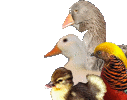For at ta emnet om arvelighedslære vs. hvidt tamfjerkræ op igen, som jeg finder utroligt interessant og har en umådelig lyst til at studere nærm. er jeg stødt på 1 mill. kr spørgsmålet.
Flemming Schiøtte artikkel om Phæo-og Eumelanin, her specielt aktuelt vedr. brun-sort kontra hvidt som blot er luftfyldte fjer.
Helt grundlæggende, hvordan får man startet på at få mindsket/fjernet Eumelanin farvestoffet fra fjer.?
Synes ikke jeg pt. kan finde noget stof i lærebøgerne.
Håber eksperterne vil bidrage med gode input.
PS. til Thorleif. Llyfr da, diolch. Yr oeddawn yn darllen yn hwyr yn nos.






 Opbygning af bund til høn...
Fra Søren M
Opbygning af bund til høn...
Fra Søren M  Walisisk harlekin
Fra AE
Walisisk harlekin
Fra AE